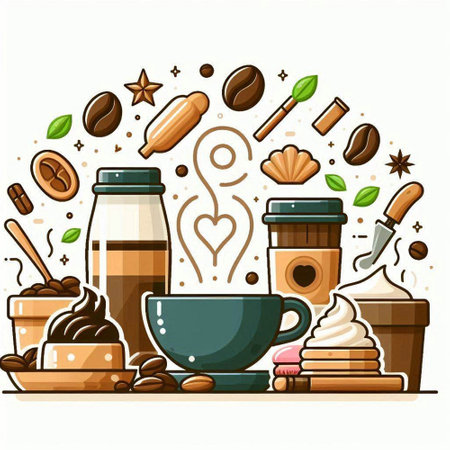Introduction: The British Love for Coffee at Home
Over the past decade, the UK has experienced a remarkable transformation in its coffee culture. No longer limited to high-street cafés or bustling city chains, the art of brewing and enjoying quality coffee—especially lattes—has taken root in British homes. From London flats to countryside cottages, more people are embracing the challenge and joy of creating their own café-style drinks, complete with intricate latte art. This growing trend speaks to both a shift in lifestyle and a desire for everyday indulgence without leaving the comfort of home. As kitchen counters fill with espresso machines and milk frothers, home brewing is no longer just a hobby; it’s becoming an essential part of modern British daily life. Whether it’s a quiet morning ritual or an activity shared among friends, making coffee at home connects people across the UK, blending tradition with contemporary taste. This article explores how Britons are navigating local laws, choosing safe appliances, and perfecting their latte art—ensuring that every homemade cup is not only delicious but also crafted responsibly.
Essential UK Laws: Safety and Appliance Standards
When creating latte art at home in the UK, understanding key laws and appliance standards is crucial for both safety and compliance. Here’s a concise overview of the main regulations affecting home coffee making:
Electrical Safety Regulations
All coffee machines and related appliances must comply with UK electrical safety standards. The Electrical Equipment (Safety) Regulations 2016 require that all electrical appliances sold in the UK meet specific safety criteria, including safe construction, insulation, and protection against electric shock. Always use coffee makers with proper plug types and ensure sockets are not overloaded.
Appliance Labelling: CE & UKCA Marks
Since Brexit, product marking has shifted from the European CE mark to the UKCA (UK Conformity Assessed) mark. Both marks indicate compliance with essential health, safety, and environmental protection standards. For home use:
| Mark | Region Accepted | What It Means |
|---|---|---|
| CE Mark | Northern Ireland & EU | Meets EU health and safety requirements |
| UKCA Mark | Great Britain (England, Scotland, Wales) | Meets UK-specific safety standards post-Brexit |
How to Check Your Appliance:
- Look for the UKCA or CE symbol on the machine or packaging.
- Check for a valid manufacturer’s address within the UK or EU.
- If purchasing online, ensure the seller provides conformity documentation.
Food Standards Agency Guidance for Home Coffee Making
The Food Standards Agency (FSA) provides guidance on food safety even in domestic settings. Key points include:
- Coffee Beans & Milk Storage: Store beans in airtight containers away from moisture and heat. Keep milk refrigerated at or below 5°C.
- Cleaning: Clean your espresso machine’s steam wand and portafilter after every use to prevent bacterial growth.
- Avoiding Cross-Contamination: Use separate cloths for cleaning milk residue and other parts of the machine.
Summary Table: Key Compliance Points for Home Baristas
| Area | Main Requirement | Your Action |
|---|---|---|
| Electrical Safety | Must comply with local regulations (2016) | Select certified machines; avoid overloading sockets |
| Appliance Labelling | Look for UKCA/CE marks; valid manufacturer info | Inspect appliance labels before purchase/use |
| Food Hygiene (FSA) | Proper storage & regular cleaning required | Store milk cold; clean equipment thoroughly daily |
Taking these steps ensures that your journey into latte art at home remains safe, legal, and enjoyable across the UK.

3. Choosing the Right Appliances: Navigating the UK Market
When brewing café-quality coffee at home in the UK, selecting the appropriate appliances is both an art and a necessity. Not only do you want your espresso machines and milk frothers to deliver on taste and texture for perfect latte art, but you also need to ensure they meet British safety standards and fit seamlessly into your living space.
Espresso Machines: Safety and Suitability
Start by checking for the UKCA (UK Conformity Assessed) mark or, if imported pre-2021, the CE mark, which confirms compliance with UK electrical safety regulations. Opt for models that run on 230V/50Hz power supplies, as these align with standard British sockets. Consider compact machines if your kitchen is modest in size—many British homes favour countertop-friendly options. Features such as automatic shut-off, insulated handles, and reliable pressure controls are essential both for safety and consistent results when pouring microfoam for latte art.
Milk Frothers: From Handheld to Integrated
Whether you choose a standalone electric frother or a steam wand integrated into your espresso machine, prioritise models with overheat protection and non-slip bases. For British users, dishwasher-safe components are particularly valued given limited drying space. If you prefer plant-based milks, verify that the device can handle varied textures without clogging or overheating—a common concern with non-dairy options popular in UK households.
Other Gadgets: Grinders and Scales
Consistency is key to great latte art. Electric burr grinders with adjustable settings allow you to dial in grind size precisely; look for units with UK plugs and enclosed hoppers to keep beans fresh despite the UKs often damp climate. Digital scales accurate to at least 0.1g help you master ratios—choose waterproof models to avoid mishaps from inevitable spills.
Ultimately, investing in certified, well-reviewed appliances ensures not only delicious results but also peace of mind regarding legal compliance and household safety. Take time to read user reviews from fellow UK residents—they often flag practical issues specific to British kitchens that overseas guides might overlook.
4. Setting Up Safely: Installation Tips for British Households
Ensuring your home coffee setup is both safe and efficient is crucial, especially given the unique characteristics of UK homes and their electrical systems. This section covers guidelines for safe appliance placement, proper electrical connections, and essential maintenance routines, all tailored to typical British kitchen layouts and sockets.
Guidelines for Safe Placement
- Worktop Space: Place your coffee machine on a stable, level surface away from the edge of the counter to prevent accidental knocks or spills.
- Ventilation: Ensure there’s adequate space around the machine (at least 10cm at the rear and sides) for heat dissipation, which helps prevent overheating and fire risks.
- Avoid Damp Areas: Keep appliances away from sinks, dishwashers, and other sources of water to minimise electrical hazards.
- Cord Management: Avoid trailing leads over cooking hobs or through walkways; use cable clips to secure cords against walls if needed.
Electrical Connections in UK Kitchens
| Appliance Type | Recommended Socket | Power Requirements | Notes |
|---|---|---|---|
| Espresso Machine (Home Grade) | 13A Switched Socket | ~1200-1800W, 230V | Do not use with extension leads or multi-plug adapters. |
| Grinder | 13A Switched Socket | <500W, 230V | Can share double socket with low-wattage appliances only. |
| Kettle/Boiler Attachment | Dedicated 13A Socket | >2000W, 230V | Avoid running simultaneously with other high-draw devices. |
- Main Guidance: Always plug directly into a wall socket where possible. If using an extension, ensure it is rated above the total wattage of connected appliances.
- No DIY Electrical Work: Under UK law, only certified electricians should modify kitchen wiring or install new sockets (see Part P of the Building Regulations).
- Earthed Sockets: All kitchen sockets should be properly earthed; check for this before installation to avoid electric shock risk.
Maintenance Routines for Longevity & Safety
- Limescale Management: Hard water is common in the UK; descale machines monthly using approved descaling agents to prevent blockages and maintain safety valves.
- Cable & Plug Checks: Inspect power cables and plugs weekly for signs of wear or damage; replace immediately if faults are found.
- Circuit Breaker Awareness: Know which circuit your appliances are on—avoid overloading by running one high-power device per circuit at a time.
- Splash Prevention: Wipe up any spills promptly to avoid slipping hazards and potential water ingress into electrical components.
- User Manuals: Follow manufacturer guidelines specific to your model—this supports warranty compliance and safe operation under UK conditions.
Troubleshooting Common Issues (Quick Reference)
| Issue | Plausible Cause | Action Step |
|---|---|---|
| No Power to Appliance | Main fuse tripped / faulty socket | Check fuse box and try another known working socket before calling an electrician. |
| Mild Electric Shock When Touching Machine | Poor earthing / water ingress | Unplug immediately and consult a qualified electrician. Do not use until resolved. |
| Loud Noise or Vibration During Use | Poorly secured placement / scale buildup inside machine | Stabilise unit; descale thoroughly as per manual instructions. |
A Note on PAT Testing (Portable Appliance Testing)
If you run coffee workshops or let others use your equipment regularly in your home, consider annual PAT testing for peace of mind—this is not mandatory for domestic settings but is good practice for those sharing their passion for latte art safely within the community.
5. Practising Latte Art: Health, Safety, and Best Practices
Safe Milk Steaming Techniques
When steaming milk at home for latte art, prioritising safety and hygiene is essential. Always use fresh, cold milk and ensure your steam wand is clean before each use. In the UK, its recommended to heat milk to between 60–65°C (140–149°F) – hot enough for a silky texture but below the temperature where proteins break down and scalding becomes a risk. Invest in a reliable food thermometer and never leave the steaming jug unattended. Be mindful of steam pressure; sudden bursts can cause burns or spills, so always release excess steam from the wand away from yourself and surfaces.
Cleaning Habits for Appliances and Utensils
Consistent cleaning is not just good practice—its crucial for health and compliance with UK home appliance guidance. After every session, purge the steam wand immediately to prevent milk residue build-up. Wash jugs, cups, and all utensils with warm soapy water and dry them thoroughly. Descale your espresso machine regularly as advised by the manufacturer; hard water is common in many parts of the UK and can affect both taste and appliance longevity. Periodic deep cleans help prevent bacterial growth and maintain equipment performance.
Creative Yet Responsible Latte Art Practice
Latte art is about experimentation, but always within safe boundaries. Keep your workspace tidy to avoid slips or cross-contamination—especially if youre working in a shared kitchen environment typical of many UK homes. Use only food-safe colourings or ingredients if you wish to add flair to your designs. If children are present, supervise closely and keep hot tools out of reach. Most importantly, respect appliance manuals and don’t bypass safety features for convenience’s sake. Developing your skills should be enjoyable but never at the expense of safety or cleanliness.
Practical Suggestions
- Start with small quantities to reduce waste during practice sessions.
- Label cleaning products clearly to avoid confusion with food items.
- Create a routine: clean as you go rather than leaving everything until after youve finished.
Summary
A safe and hygienic approach to home latte art not only ensures compliance with UK norms but also helps preserve your equipment and personal wellbeing. By integrating these best practices into your daily routine, you’ll enjoy creative coffee moments with peace of mind.
6. Community Resources: Local Groups and UK Coffee Culture
When it comes to honing your latte art skills safely and effectively at home in the UK, tapping into local community resources can make a substantial difference. The British coffee scene is robust, inclusive, and well-connected, providing ample opportunities for both new and seasoned home brewers to learn, share, and grow.
UK-Based Forums
Online forums such as Coffee Forums UK and regional Facebook groups like London Coffee Lovers or Northern Baristas are excellent starting points. These platforms offer threads on legal appliance use, sourcing equipment compliant with UK safety standards, troubleshooting machine issues, and sharing latte art techniques specific to British tastes. Engaging in these conversations will not only provide technical advice but also insights into the unique preferences of the UK coffee community.
Barista Workshops and Training Sessions
Across the UK, many independent cafés and roasteries offer hands-on barista workshops tailored for home enthusiasts. Courses at places like The Gentlemen Baristas in London or North Star Coffee Academy in Leeds cover safe espresso extraction, milk texturing using domestic appliances, and essential cleaning routines aligned with local safety regulations. These workshops often emphasise practical tips you can apply immediately in your own kitchen.
Support from the British Coffee Community
The UK coffee culture is inherently collaborative. Initiatives such as the Specialty Coffee Association (SCA) UK Chapter regularly host events that welcome hobbyists alongside professionals. You’ll find open-invitation cupping sessions, pop-up latte art throwdowns, and social meet-ups where safety practices and appliance guidance are discussed openly. Such gatherings foster a supportive environment where newcomers can ask questions without judgement.
If you’re serious about developing your craft within legal boundaries and want to stay updated on best practices, joining these communities—online or in-person—is invaluable. The collective wisdom of British coffee lovers ensures that aspiring home baristas are never isolated in their journey toward safe and satisfying latte art at home.
7. Conclusion: Enjoying Coffee Creation with Peace of Mind
Embracing the art of home coffee making in the UK is more than just a hobby—it’s a celebration of creativity, community, and personal well-being. As you embark on your journey to perfecting latte art, it’s essential to keep safety and legal compliance at the forefront. By understanding and adhering to UK appliance standards, electrical regulations, and food safety guidelines, you protect yourself and those you share your creations with. Furthermore, staying connected with local coffee communities—whether online or through neighbourhood events—fosters knowledge sharing and enriches your practice. Let this awareness empower you rather than hinder your passion; safe practices and compliance are not barriers but enablers for worry-free enjoyment. In essence, every carefully poured rosette or heart atop your homemade latte is a testament to your commitment—not only to quality coffee but also to responsible craftsmanship within the unique context of British home life. So fill your cup confidently, knowing you’ve taken every step to enjoy coffee creation at home with true peace of mind.


